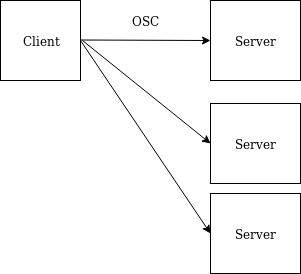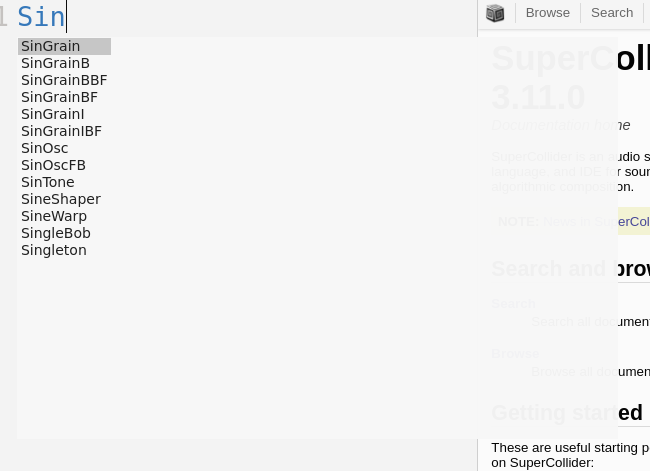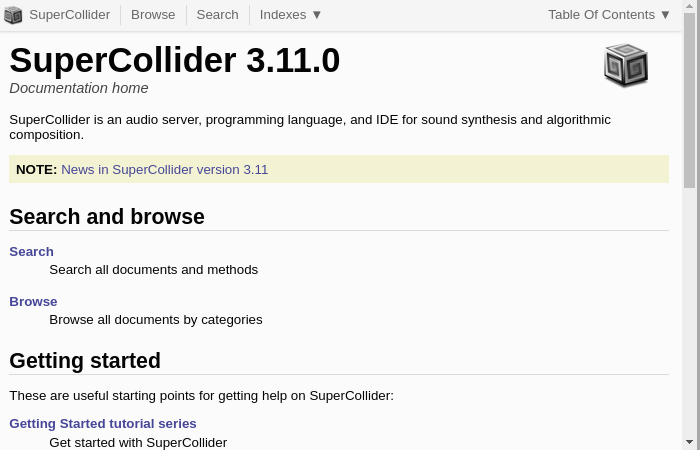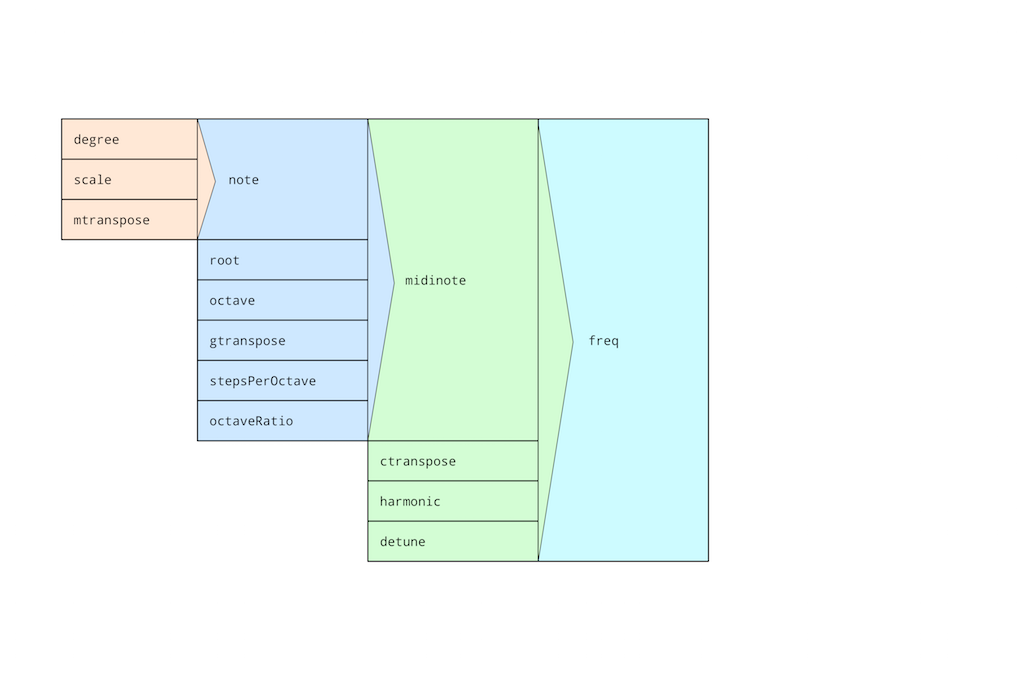These are workshop notes for the online introductory SuperCollider workshop put on by Notam in September 2020. It covers the basics of using the pattern library in SuperCollider
You can download the notes here: workshop-notes
Design
Short history of SuperCollider
SC was designed by James McCartney as closed source proprietary software
Version 1 came out in 1996 based on a Max object called Pyrite. Cost 250$+shipping and could only run on PowerMacs.
Became free open source software in 2002 and is now cross platform and is now maintained by a wonderful group of developers.
Overview
When you download SuperCollider, you get an application that consists of 3 separate programs:
- The IDE, a smart text editor
- The SuperCollider language / client (sclang)
- The SuperCollider sound server (scsynth)
Architecture

The client (language and interpreter) communicates with the server (signal processing)
This happens over the network using Open Sound Control
Multiple servers

This modular / networked design means one client can control many servers
Consequences of SC’s modular design
Each of SuperCollider’s components are replacable:
IDE <—> SCIDE, (N)Vim, Atom or VSCode
language <—> Python, CLisp, TidalCycles, Javascript
server <—> Max/MSP, Ableton Live, Reaper
Extending SuperCollider
The functionality of SuperCollider can be extended using external packages
These are called Quarks and can be installed using SuperCollider itself
// Install packages via GUI (does not contain all packages)
Quarks.gui;
// Install package outside of gui using URL
Quarks.install("https://github.com/madskjeldgaard/KloudGen");
SC Plugins
SC3 Plugins is a collection of user contributed code, mostly for making sound
The plugins are quite essential (and of varying quality / maintenance)
How to use the IDE
The IDE is the text editor that comes with SuperCollider. It has some really smart features that are really helpful when writing code.
Important keyboard shortcuts
- Open help file for thing under cursor: Ctrl/cmd + d
- Evaluate code block: Ctrl/cmd + enter
- Stop all running code: Ctrl/cmd + .
- Start audio server: Ctrl/cmd + b
- Recompile: Ctrl/cmd + shift + l
- Clear post window: Ctrl/cmd + shift + p
The IDE as a calculator
SuperCollider is an interpreted language
This means we can “live code” it without waiting for it to compile
A good example of this is using it as a calculator. Try typing 2+2 and
evaluate it:
2+2
-> 4
Autocompletion

Start typing Sin and see a menu pop up with suggestions (and help
files).
Use up/down arrow keys to navigate and hit enter to choose one
The status line

Shows information about system usage
Right click to see server options + volume slider
Help browser

There is an interactive help browser available.
You can select and evaluate all code in the browser and see / hear the results immediately.
Help browser online
There’s an online version of the help system available at doc.sccode.org/ which is really helpful for sharing links to documentation.
Post window
This is where you see the resulting return messages of the code you have evaluated
This is also where you see error messages posted.
About patterns
What is a pattern?
“[The Pattern] classes form a rich and concise score language for music”
In other words:
Patterns are used to sequence and compose music
The cool thing about this is it is music treated as data.
This means we can easily transpose, stretch and warp the composition like you will see in the following (instead of manually doing all of these things in a DAW).
This means for example that composing a 4 bar loop is not necessarily any more or less work than a 4 hour one.
Guides in the help system
Patterns are pretty well documented in the help system:
Event patterns - Sequence sound events
What is a (sound) event?
Think of what happens when you press the key of a piano
What data does that involve?
- Duration of key press
- Pitch of the key
- Sustain (are you holding the foot pedal?)
- etc. etc.
What does an Event look like?
Make sure your server is booted before trying this:
// See the post window when evaluating these
().play; // Default event
(freq:999).play;
(freq:123, sustain: 8).play;
Changing the default synth
The default synth sucks
You can change it by defining a new synth called \default
More info on my website
Introducing the almighty Pbind
Arguably the most important pattern class in SuperCollider
A Pbind simply consists of a list of key/value pairs.
In this example, the keys are on the left side ( \dur and \degree ) and the values on the right ( 1/4 and 0 ).
// Play quarter notes (try changing the 0 to another integer)
Pbind(
\dur, 1/4,
\degree, 0
).play
Note the commas: This is what makes it a list.
Keys correspond to Synth arguments
Most often, keys correspond to a Synth’s arguments.
Example: If a SynthDef has the argument cutoff, we can access that
argument in a Pbind using \cutoff.
Important note on the dur key
\dur is used in most SynthDefs to specify the duration of a
note/event.
Make sure this key never gets the value 0.
When does a Pbind end?
If one of the keys of a Pbind are supplied with a fixed length value pattern, the one running out of values first, will make the Pbind end.
Live coding: Pdef
Live coding patterns: Wrap your event pattern (Pbind) in a Pdef:
Pdef('myCoolPattern', Pbind(...)).play;
The Pdef has a name ‘myCoolPattern’ which is a kind of data slot accessible throughout your system
Every time you evaluate this code, it overwrites that data slot (maintaining only one copy)
Value patterns - Generate data for your event patterns
The building blocks of compositions
Basic building blocks:
- List patterns -
Pseq - Random value patterns, eg
Pwhite,Pbrown - Random sequence patterns -
Pshuf,Prand, etc. - Rests
Slightly more advanced building blocks:
- Envelope patterns like
PsegorPstep - Data sharing between event parameters, eg
Plambda- - Patterns in patterns
Advanced:
- Generate patterns / Pattern spawning - eg.
Pspawn
List patterns
See all of them here
Testing value patterns: asStream
You will see the .asStream method a lot in the documentation for value patterns.
// Pattern
p Pseq([1,2,3]);
// Convert to stream
p p.asStream;
// See what values the pattern produces
p.next; // 1, 2, 3, nil
Pseq: Classic sequencer
// Play values 1 then 2 then 3
Pseq([1,2,3]);
// 4 to the floor
Pseq([1,1,1,1]);
Random value patterns: Pwhite and Pbrown
// (Pseudo) random values
Pwhite(lo: 0.0, hi: 1.0, length: inf);
// Drunk walk
Pbrown(lo: 0.0, hi: 1.0, step: 0.125, length: inf);
Random sequence patterns: Prand and Pxrand
// Randomly choose from a list
Prand([1,2,3],inf);
// Randomly choose from a list (no repeating elements)
Pxrand([1,2,3],inf);
Probability: Pwrand
Choose items in a list depending on probability
// 50/50 chance of either 1 or 10
Pwrand([1, 10], [0.5, 0.5])
// 25% chance of 1, 25% change of 3, 50% chance of 7
Pwrand([1, 3, 7], [0.25, 0.25, 0.5])
// 30% chance of 3, 40% change of 2, 30% chance of 5
Pwrand([4, 2, 5], [0.3, 0.4, 0.3])
Envelope pattern: Pseg
// Linear envelope from 1 to 5 in 4 beats
Pseg( levels: [1, 5], durs: 4, curves: \linear);
// Exponential envelope from 10 to 10000 in 8 beats
Pseg( levels: [10, 10000], durs: 8, curves: \exp);
Rest
Skip/sleep a pattern using Rest. If used in the \dur key of a
Pbind, the value in the parenthesis is the sleep time
// One beat, two beats, rest 1 beat, 3 beats
Pbind(\dur, Pseq([1,2,Rest(1),3])).play;
Pkey: Share data between event keys
Using Pkey we can make an event’s parameters interact with eachother
// The higher the scale degree
// ... the shorter the sound
Pbind(
\degree, Pwhite(1,10),
\dur, 1 / Pkey(\degree)
).play
More info about data sharing in patterns: here
patterns in patterns: The computer music inception
You can put patterns in almost all parts of patterns.
This may lead to interesting results:
// A sequence with 3 random values at the end
Pseq([1,2,Pwhite(1,10,3)]);
// An exponential envelope of random length
Pseg(levels: [10, 10000], durs: Pwhite(1,10), curves: \exp);
Working with pitches
The pattern library comes with a bunch of useful features for working with pitches in a convenient and interesting way.
The pitch model

Changing scales
// Use the \scale key, pass in a Scale object
Pbind(\scale, Scale.minor, \degree, Pseq((1..10))).play;
Pbind(\scale, Scale.major, \degree, Pseq((1..10))).play;
Pbind(\scale, Scale.bhairav, \degree, Pseq((1..10))).play;
Available scales
// See all available scales
Scale.directory.postln
Changing root note
// Use the \root key to transpose root note (halftones)
Pbind(\root, 0, \degree, Pseq((1..10))).play;
Pbind(\root, 1, \degree, Pseq((1..10))).play;
Pbind(\root, 2, \degree, Pseq((1..10))).play;
Changing octaves
// Use the \octave key
Pbind(\octave, Pseq([2,4,5],inf), \degree, Pseq((1..10))).play;
Pbind(\octave, Pwhite(3,6), \degree, Pseq((1..10))).play;
Pbind(\octave, 7, \degree, Pseq((1..10))).play;
Playing chords
// Add an array of numbers to the degree parameter
// to play several synths at the same time (as a chord)
Pbind(\degree, [0,2,5] + Pseq([2,4,5],inf), \dur, 0.25).play;
Changing tempo
The tempo of patterns are controlled by the TempoClock class You can either create your own TempoClock or modify the default clock like below
TempoClock.default.tempo_(0.5) // Half tempo
TempoClock.default.tempo_(0.25) // quarter tempo
TempoClock.default.tempo_(1) // normal tempo
Further learning resources
Videos
Tutorials by Eli Fieldsteel covering a range of subjects: SuperCollider Tutorials
E-book
Paper:
Community
Awesome SuperCollider
A curated list of SuperCollider stuff
Find inspiration and (a lot more) more resources here:
Learning to code: Advice
- Practice 5 minutes every day
- Set yourself goals: Make (small) projects
- Use the community
- Contribute to SuperCollider - improve documentation, help out on the forums or make bug reports